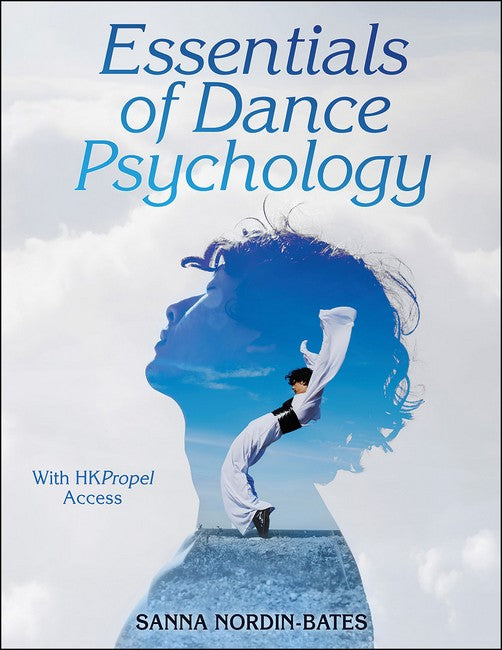Sanna Nordin-Bates is an associate professor at the Swedish School of Sport and Health Sciences in Stockholm. She has taught dance and sport psychology courses for more than 15 years and has authored or coauthored over 40 journal articles in the area. Nordin-Bates has a PhD in sport and exercise sciences, with a focus on dance psychology, from the University of Birmingham. She is a chartered member of the British Psychological Society. She also has further education in cognitive behavioral therapy for elite sport and is a certified mindfulness instructor. Nordin-Bates has served as an applied dance psychology consultant for English National Ballet, the Royal Ballet Upper School in London, and the Royal Swedish Ballet School. She is a fellow of the International Association for Dance Medicine & Science and is a regularly invited speaker and guest teacher at a number of universities and organizations.
Request Academic Copy
Please copy the ISBN for submitting review copy form
Description
Introduction to Dance Psychology What Is Dance Psychology? Cognitive Behavioral Therapy in Dance Psychology Part I. Individual Differences Chapter 1. Personality What Is Personality? Structure of Personality Origins of Personality Consequences of Personality Narrow Identity: Are Dancers at Risk? Chapter 2. Perfectionism What Is Perfectionism? Origins of Perfectionism in Dance Consequences of Perfectionism How Can Perfectionism Be Managed? Chapter 3. Self-Esteem and Self-Confidence What Are Self-Esteem and Self-Confidence? Origins of Self-Esteem Consequences of Self-Esteem Origins of Self-Confidence Consequences of Self-Confidence How Can Self-Esteem and Self-Confidence Be Strengthened? Chapter 4. Anxiety What Is Anxiety? Sources of Anxiety Consequences of Anxiety How Can Anxiety Be Managed? Part II. Dance-Specific Characteristics and Dispositions Chapter 5. Motivation What Is Motivation? Achievement Goal Theory Perspective on Motivation Self-Determination Theory Perspective on Motivation How Can Healthy Motivation Be Nurtured? An Intrapersonal Perspective Chapter 6. Attentional Focus What Is Attentional Focus? Performance-Related Consequences of Different Attentional Foci Attentional Focus Research in Dance Why Attentional Focus Has an Impact How Can Optimal Attentional Focus Be Nurtured? Chapter 7. Creativity What Is Creativity? Sources of Creativity Correlates of Creativity How Can Creativity Be Nurtured? Part III. Psychological Skills Chapter 8. Mindfulness What Is Mindfulness? Origins of Mindfulness Consequences of Mindfulness Mindfulness Research in Dance Why Mindfulness Has an Impact How Can Mindfulness Be Nurtured? Chapter 9. Goal Setting and Self-Regulation What Is Goal Setting? Sources of Goals: Assigned Goals Versus Personal Values Consequences of Goal Setting Why Goal Setting Has an Impact What Is Self-Regulation? How Can Goal Setting and Self-Regulation Be Optimized? Chapter 10. Imagery What Is Imagery? Revised Applied Model of Deliberate Imagery Use Sources of Imagery Consequences of Imagery Why Imagery Has an Impact How Can Imagery Be Optimized? Part IV. Dance Environments and Challenges Chapter 11. Motivational Climates What Is a Motivational Climate? Achievement Goal Theory (AGT) Perspective: Task- and Ego-Involving Climates Self-Determination Theory Perspective: Need-Supportive Versus Controlling Leadership Origins of Motivational Climates: What Makes Teachers Support or Thwart Healthy Motivation? Consequences of Motivational Climates How Are Healthy Motivational Climates Created? Chapter 12. Talent What Is Talent? Sources of Talent Consequences of Talent Beliefs and of Talent Identification How Can Talent Identification and Development Be Optimized? Chapter 13. Injury What Are the Key Psychological Aspects of Injury in Dance? Psychological Risk Factors for Acute Injury: Stress-Injury Model Beyond the Stress-Injury Model: Other Psychological Risk Factors for Dance Injury Dancers' Experiences of Becoming and of Being Injured Psychological Aspects of Injury Rehabilitation Using Psychology to Reduce Injury Risk and Optimize Rehabilitation Chapter 14. Body Image and Disordered Eating What Is Body Image? Eating Disorders Versus Disordered Eating Origins of Negative Body Image and Disordered Eating in Dance Consequences of Body Image and Disordered Eating How Can Healthy Body Image Be Nurtured? How Can Disordered Eating Be Prevented, Identified, and Managed?

